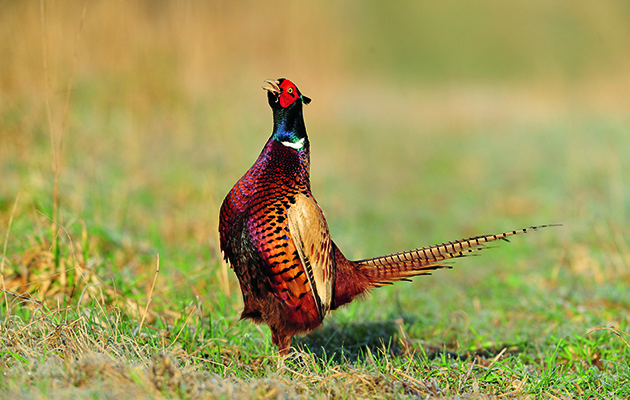How to improve the biosecurity on your shoot
Biosecurity is one of the best ways to keep rearing fields free of disease and has the added financial benefit of cutting costs, says vet Charlotte Commins

Biosecurity is a set of preventative measures designed to protect a farm or rearing field from the entry and spread of infectious diseases. Disease can be spread a number of ways: through contaminated feed, water, equipment, vehicles or people; contact with other flocks or the wild bird population; via faeces and secretions and vermin; the introduction of new stock with unknown health status and unsatisfactory cleaning and disinfection.
Improving biosecurity can bring about significant benefits, including better flock health, productivity and bird performance, plus cutting costs associated with bird mortality and treatment of disease. It can also limit the spread of disease throughout the farm.
With the constant threat of notifiable diseases such as bird flu and Newcastle disease, as well as diseases endemic within the UK, good biosecurity is key to a healthy bird and a healthy business.
People
Visitors pose the greatest biosecurity risk, so limiting the number of people who can access the site reduces the risk. Gates and signage can deter people from entering the site, and if vehicles can access the site, providing a pump sprayer with disinfectant to be used as a wheel wash, will help. This can cost as little as £15 and can reduce the risk of potential pathogens. A visitor’s log will help to keep track of who has entered and when. You can also record sites that visitors have entered in the previous 48 hours, which can be useful if there is an outbreak of disease.
Providing clean overalls, boots and hand sanitisers can ensure that disease isn’t spread from outside sources. This can also be implemented to stop cross- contamination between pens. Providing covered foot dips stops dilution of the disinfectant by rain. It also prevents the sunlight and dropped leaves from breaking down the active chemicals in the disinfectant.

Disinfecting all equipment, such as feeders and drinkers, will reduce risk of spreading disease
Equipment
All equipment should be thoroughly washed and disinfected at the end of the rearing period to reduce the risk of disease agents remaining over winter. Cleaning and disinfection can be difficult because gamebirds’ housing is usually made of wood and wire. Using a disinfectant that targets coccidial oocysts will reduce cross- contamination to the next crop. Using the recommended concentration and contact time of a product will improve its efficacy.
Knowledge of bird health
Keeping in touch with the poult supplier or hatchery to determine the health status of the birds being delivered will be beneficial. Storing a sample of chick box papers in the freezer can be useful to refer to if problems are encountered during rearing. Knowing where the delivery lorry has been previously and the species that are being carried can also be important.
Preparation and health plans
An annual veterinary health plan is a good idea because this is when you can review the previous season’s problems and any disease risks ahead. Health plans will include tailored information such as hygiene programmes, storage and recording of medicines, carcase disposals, routine monitoring and pest control.

Top tips for improving biosecurity on your shoot
Monitoring
Keeping decent records is not only good practice, but it also allows for early detection of diseases. Monitoring mortality can alert the stockman to a problem. Early detection allows early intervention, which in turn can reduce losses and the associated costs. Records should take the form of individual pen cards where the daily mortality and any interventions are recorded. Having a colour-coded flag system for larger rearing fields will also make any problem pens more easily identifiable.
The importance of simple biosecurity should not be underestimated — a good strategy can prevent disease, improve bird welfare, cut losses and significantly improve performance.

Top tips for improving biosecurity on your shoot
Keeping disease out
Keeping feed and water in covered areas can reduce access by the wild bird population, as can removing feed spillages that attract vermin. Faecal pellets from vermin can contaminate feed, spreading pathogens such as salmonella. Bait stations can reduce this risk and should be frequently monitored. Ensuring that feeders and drinkers are kept clean is another important management factor because all birds will have contact with this area; if these are harbouring pathogens, disease will spread quickly. Regularly moving feeders and drinkers to clean areas within the release pens will also minimise the risk.
Younger birds are more susceptible to disease, therefore a cheap and easy way to minimise disease risk is to attend to younger birds first and move through to the oldest birds last, or have a designated person working with the youngest birds, for example those less than seven days old. Isolating sick stock will reduce spread to other birds if they are contagious. This can be in a simple “nursing” pen, specifically for birds that can less easily compete for feed and water.
Top tips to improve biosecurity on your shoot
Know your risks. This is the only way you can minimise them.
Limit site access, as visitors pose a large risk to biosecurity.
Don’t neglect drinking water hygiene.
A large number of birds share the same drinking source, which if contaminated can lead to the rapid spread of a disease.
Change foot dips regularly because they lose efficacy when in contact with organic matter.
Keeping good records allows for early detection of problems, so that they can be rectified quickly.
Charlotte Commins, BVetMed MRCVS, is a vet at Slate Hall Veterinary Practice in Rampton, Cambridgeshire.








